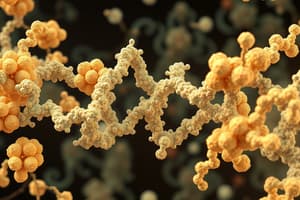Podcast
Questions and Answers
What is the enzyme produced in the stomach responsible for protein digestion?
What is the enzyme produced in the stomach responsible for protein digestion?
- Amylase
- Trypsin
- Lipase
- Pepsin (correct)
What are the subunits of proteins?
What are the subunits of proteins?
- Amino acids (correct)
- Glycerol
- Fatty acids
- Glucose
What are the subunits of carbohydrates?
What are the subunits of carbohydrates?
- Fatty acids
- Glycerol
- Amino acids
- Glucose (correct)
What are the subunits of fats?
What are the subunits of fats?
What process forms large molecules from smaller building blocks?
What process forms large molecules from smaller building blocks?
What is the optimal pH for pepsin activity?
What is the optimal pH for pepsin activity?
What color does the biuret reagent turn when protein is digested in the 'Digestion of Protein' experiment?
What color does the biuret reagent turn when protein is digested in the 'Digestion of Protein' experiment?
What are the subunits of carbohydrates?
What are the subunits of carbohydrates?
What are the subunits of fats?
What are the subunits of fats?
What process forms large molecules from smaller building blocks?
What process forms large molecules from smaller building blocks?
Flashcards
Protein digestion enzyme
Protein digestion enzyme
Pepsin is the enzyme produced in the stomach.
Protein subunits
Protein subunits
Amino acids are the building blocks of proteins.
Carb subunits
Carb subunits
Glucose is the subunit of carbohydrates.
Fat subunits
Fat subunits
Signup and view all the flashcards
Large molecules from small
Large molecules from small
Signup and view all the flashcards
Pepsin's pH
Pepsin's pH
Signup and view all the flashcards
Biuret reagent color
Biuret reagent color
Signup and view all the flashcards
Carbohydrate subunits
Carbohydrate subunits
Signup and view all the flashcards
Fat subunits
Fat subunits
Signup and view all the flashcards
Dehydration synthesis
Dehydration synthesis
Signup and view all the flashcards
Study Notes
Enzymes and Digestion
- Pepsin is the enzyme produced in the stomach that is responsible for protein digestion.
- Optimal pH for pepsin activity is around 1.5 to 2, which creates an acidic environment for effective protein breakdown.
Protein Subunits
- Proteins are composed of amino acids, which are the basic building blocks of proteins.
- There are 20 different amino acids that combine in various sequences to form proteins.
Carbohydrate Subunits
- Carbohydrates are made up of monosaccharides, the simplest form of carbohydrates.
- Common monosaccharides include glucose, fructose, and galactose.
Fat Subunits
- Fats, or lipids, are primarily composed of fatty acids and glycerol.
- Triglycerides, the most common type of fat, consist of three fatty acids bonded to one glycerol molecule.
Synthesis of Macromolecules
- Polymerization is the process that forms large molecules (macromolecules) from smaller building blocks like amino acids, monosaccharides, and fatty acids.
Experiment Observations
- In the "Digestion of Protein" experiment, the biuret reagent turns purple when proteins are digested, indicating the presence of peptides or amino acids.
Studying That Suits You
Use AI to generate personalized quizzes and flashcards to suit your learning preferences.




